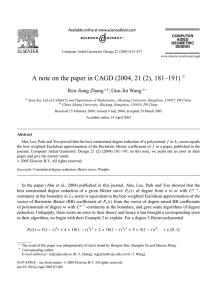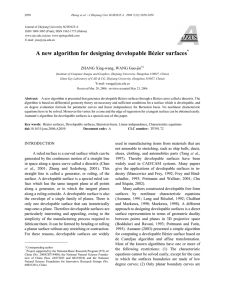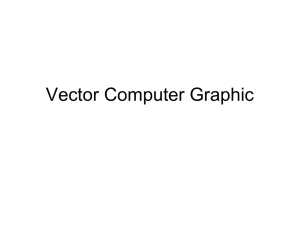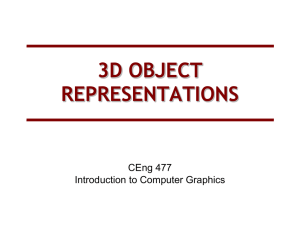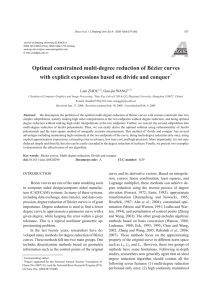Design of Rational Bézier Developable Surface Pencil Through A Common Isogeodesic
advertisement
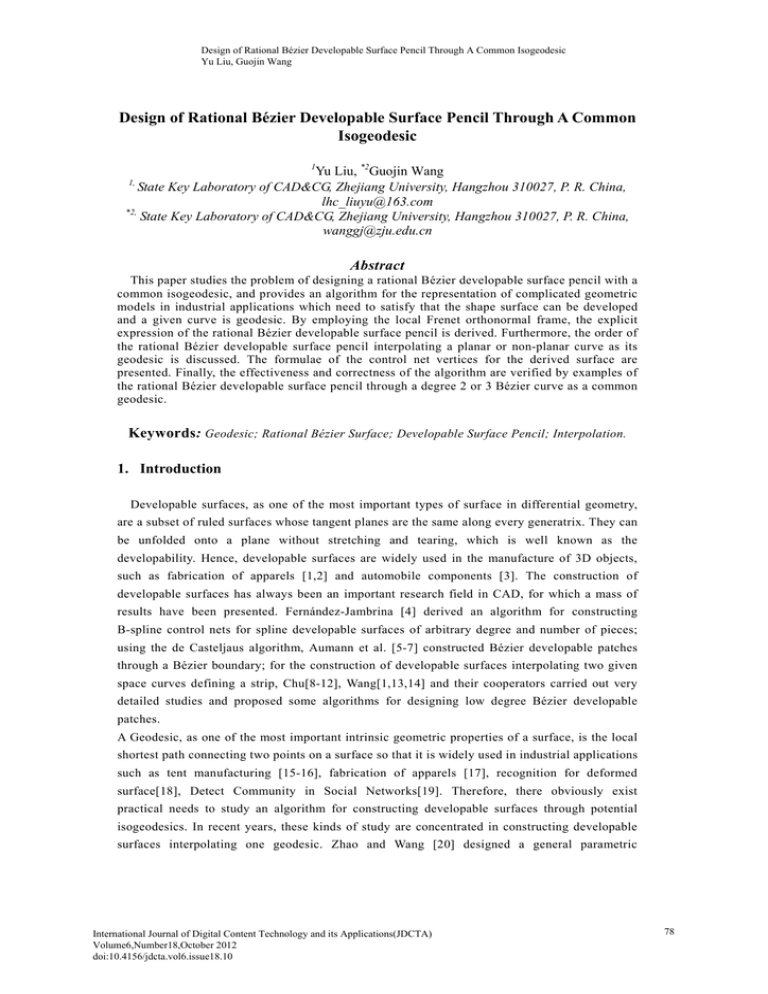
Design of Rational Bézier Developable Surface Pencil Through A Common Isogeodesic Yu Liu, Guojin Wang Design of Rational Bézier Developable Surface Pencil Through A Common Isogeodesic 1 Yu Liu, *2Guojin Wang 1, State Key Laboratory of CAD&CG, Zhejiang University, Hangzhou 310027, P. R. China, lhc_liuyu@163.com *2, State Key Laboratory of CAD&CG, Zhejiang University, Hangzhou 310027, P. R. China, wanggj@zju.edu.cn Abstract This paper studies the problem of designing a rational Bézier developable surface pencil with a common isogeodesic, and provides an algorithm for the representation of complicated geometric models in industrial applications which need to satisfy that the shape surface can be developed and a given curve is geodesic. By employing the local Frenet orthonormal frame, the explicit expression of the rational Bézier developable surface pencil is derived. Furthermore, the order of the rational Bézier developable surface pencil interpolating a planar or non-planar curve as its geodesic is discussed. The formulae of the control net vertices for the derived surface are presented. Finally, the effectiveness and correctness of the algorithm are verified by examples of the rational Bézier developable surface pencil through a degree 2 or 3 Bézier curve as a common geodesic. Keywords: Geodesic; Rational Bézier Surface; Developable Surface Pencil; Interpolation. 1. Introduction Developable surfaces, as one of the most important types of surface in differential geometry, are a subset of ruled surfaces whose tangent planes are the same along every generatrix. They can be unfolded onto a plane without stretching and tearing, which is well known as the developability. Hence, developable surfaces are widely used in the manufacture of 3D objects, such as fabrication of apparels [1,2] and automobile components [3]. The construction of developable surfaces has always been an important research field in CAD, for which a mass of results have been presented. Fernández-Jambrina [4] derived an algorithm for constructing B-spline control nets for spline developable surfaces of arbitrary degree and number of pieces; using the de Casteljaus algorithm, Aumann et al. [5-7] constructed Bézier developable patches through a Bézier boundary; for the construction of developable surfaces interpolating two given space curves defining a strip, Chu[8-12], Wang[1,13,14] and their cooperators carried out very detailed studies and proposed some algorithms for designing low degree Bézier developable patches. A Geodesic, as one of the most important intrinsic geometric properties of a surface, is the local shortest path connecting two points on a surface so that it is widely used in industrial applications such as tent manufacturing [15-16], fabrication of apparels [17], recognition for deformed surface[18], Detect Community in Social Networks[19]. Therefore, there obviously exist practical needs to study an algorithm for constructing developable surfaces through potential isogeodesics. In recent years, these kinds of study are concentrated in constructing developable surfaces interpolating one geodesic. Zhao and Wang [20] designed a general parametric International Journal of Digital Content Technology and its Applications(JDCTA) Volume6,Number18,October 2012 doi:10.4156/jdcta.vol6.issue18.10 78 Design of Rational Bézier Developable Surface Pencil Through A Common Isogeodesic Yu Liu, Guojin Wang developable surface pencil through a given curve as its common geodesic; Li et al. [21] derived an algorithm for creating the general parametric developable surfaces through a given low degree Bézier curve as its geodesic. However, the algorithm for designing rational Bézier developable surfaces through Bézier curves as geodesics has not been presented yet, and it is well known that the kind of rational Bézier surfaces, which takes a dominant position in CAD system, is used more widely than the general parametric surface. Since the recent algorithms cannot meet the practical needs of expressing the modern large-scale industrial complex geometric models, it is urgent to present an algorithm of designing a rational Bézier developable surface pencil through a given Bézier curve as its common geodesic, for which this paper will go on in-depth study. The reminder of the paper is organized as follows. In Section 2, some properties of Bézier curve are reviewed. In Section 3, the algorithm of designing a rational Bézier developable surface pencil through a given Bézier curve as its common geodesic is presented and the formulae of its control points are derived. The algorithm is executed by programming and some examples are illustrated in Section 4. Finally, this paper is summed up in Section 5. 2. Preliminaries mi Let L degree mi Bézier curves be Ri r B mj i r Q ij , 0 r 1, i 1, 2, , L . Denote the j 0 dot and cross product between two vectors a and b by 1 and 2 , respectively. By calculating the dot and cross products of the above Bézier curves, we can obtain R1 r m1 R2 r mL1 RL r m1 m2 mL j 0 m1 m2 mL 1 Qk1 m1 k1 k2 k L j k1 k 2 kL j ! m1 m2 mL j ! B mj 1 m2 mL r m1 m2 mL ! Qk22 m2 mL1 QkmLL , 0 r 1, (1) m where mi 1, 2, i 1, 2, , L 1, 0, i m, Qki i 0 , ki mi , . i The correctness of Eq. (1) is based on the mathematical induction and the following formulae, which is obtained by calculating the dot and cross product between two degree mi1 and mi2 Bézier curves, respectively, 79 Design of Rational Bézier Developable Surface Pencil Through A Common Isogeodesic Yu Liu, Guojin Wang Ri1 r Ri2 r B0 i1 r Q0i1 B1 i1 r Q1i1 Bmii1 r Qmi1i B0 i2 r Q0i2 B1 i2 r Q1i2 Bmii2 r Qmi2i m m 1 B mi1 0 m r B r Q Q mi1 mi2 j 0 mi2 0 i1 0 m mi2 B j i1 i2 0 m B mi1 1 i1 m m mi2 ! mi2 0 i1 1 mi1 mi2 ki1 ki2 j k1 k 2 m 2 r B r Q Q j ! mi mi j ! 1 2 r 1 i2 0 B mi1 mi1 2 r B r Q Q mi2 mi2 i1 mi1 i2 mi2 T i1 i Qki1 Qk2i2 , 0 r 1, 1 i1 , i2 L, 1, 2. m he s -th derivative vectors of a degree m Bézier curve R r B mj r Q j , 0 r 1 are [23] j 0 R s r m! m s ms B j r s Q j , 0 r 1. m s ! j 0 (2) sˆ Q j s 1 Q j 1 Q j , sˆ 1, 2, , s; j 0,1, , m sˆ, 0 Q j Q j , j 0,1, , m. ˆ Let R r be a curve on the surface P r , t . According to the theorem about geodesics in differential geometry [22], the expression of a developable surface pencil P r , t through a given spatial curve R r as its common geodesic can be presented by [20] P r , t R r t t0 r R r R r R r R r R r 2 R r R r R r R r , 2 0 r 1, 0 t , t0 1. (3) 3. A rational Bézier developable surface pencil through a spatial curve as its common geodesic This section will design a rational Bézier developable surface pencil through a given curve as a common geodesic, present the formulae to evaluate the control points and discuss the degree of the derived rational Bézier developable surface. m Suppose R r Bim r Qi , 0 r 1 is the given degree m spatial Bézier curve. In order i 0 to obtain the expression of the rational Bézier developable surface pencil, let n be a positive integer to be fixed, be a positive integer correlative with n, m and ai i 0 , j j 0 n be two groups of positive real number correlative with the shape of a developable surface in the pencil, then by setting the control function r in Eq. 3 as follows: 80 Design of Rational Bézier Developable Surface Pencil Through A Common Isogeodesic Yu Liu, Guojin Wang r a r r , a r n 1 m6 m 1 2 B r a , r B r ,0 r 1, i 0 n i i j 0 j j (4) defining similarly with Section 2, m 2 0, i m;Tk 0 , k m 1; Tk 0 , k m 2; Tk 0, k m 3; ak 0, k n. i and denoting D1 r R r R r R r R r R r a r , 2 D 2 r R r R r R r R r a r , 2 we can obtain D1 r 6 m 9 n i 0 Bi6 m 9 n r Di1 , (5) Bi6 m 9 n r Di2 (6) D2 r 6 m 9 n i 0 based on Eq.-s (1) and (2) finally, where Di1 m 1 m 2 m 3 m 1 m 1 m 1 n m2 6m 9 n k1 k6 k7 i k1 k2 k3 k4 k5 k6 k7 i (7) ak7 Tk1 , Tk2 , 2Tk3 Tk4 Tk5 Tk6 , Di2 m 1 m 1 m 2 m 1 m 2 m 1 m 2 n 6 m 9 n k1 k6 k7 i k1 k2 k3 k4 k5 k6 k7 i ak7 Tk1 Tk2 Tk3 Tk4 Tk5 Tk6 (8) , and k j 0, j 1, , 7. By substituting Eq.-s (4), (5) and (6) into Eq. (3), we have 81 Design of Rational Bézier Developable Surface Pencil Through A Common Isogeodesic Yu Liu, Guojin Wang P r, t B r B r Q t t D r D r j 0 m j j i 0 m i 1 i 2 0 r , 0 r 1, 0 t , t0 1. Furthermore, using Eq. (1), the above formula can be simplified to P r, t V r t t0 D1 r D 2 r r , 0 r 1, 0 t , t0 1, (9) in which V r m B r V , 0 r 1, i 0 m i (10) i Vi min i , m 1 k Qi k . m k max 0,i m k i k i (11) Suppose M r , t V r t t0 D1 r D 2 r , 0 r 1, 0 t , t0 1 , and we discuss the degree of the surface M r , t . Firstly, the following lemma is presented. m Lemma 1 Suppose R r Bim r Qi , 0 r 1 is a given degree m Bézier curve. The degree i 0 2m 1 curve W r R r R r can be reduced by degree 1, which means the degree of W r is 2m 2 . m 1 Proof: According to Eq. (2), we obtain R r m Bim 1 r Qi 1 Qi . Denote Bim as a i 0 short-hand for Bim r , and hence it is clear that for i, j 0, i j , the coefficients of all of the vector Qi Q j comprised in the expansion of the vector function W r are Bim B mj 1 Bim B mj 11 B mj Bim 1 B mj Bim11 r i j 1 1 r 2 m 2 i j 1 82 Design of Rational Bézier Developable Surface Pencil Through A Common Isogeodesic Yu Liu, Guojin Wang m m 1 m m 1 m m 1 m m 1 r 1 r r 1 r i j 1 j i j i 1 i j 2 m 2 i j 1 m m m m m m 1 m m 1 r i j 1 1 r r i j j i i j 1 j i 1 Bi2mj 12 i j 1! 2m i j ! m m 1 m m 1 . 2m 2 ! i j 1 j i 1 Thus, for i, j 0, i j , the degree of Qi Q j that included in the vector function W r is 2m 2 ; in addition, for the case of i 0 or j 0 , the degree of Qi Q j is 2m 2 similarly. Therefore, the degree of the curve W r is 2m 2 . This completes the proof. Lemma 1 indicates that the Bézier curve obtained by the cross product between a given Bézier curve and its first derivative curve can be reduced by degree 1. Thus for setting 5m 12 n , the degree of the Bézier curve V r in Eq. 10 is less than or equal to 6m 12 n . Now we can discuss the degree of the surface M r , t in two cases. For one case that R r is a non planar Bézier curve, according to Lemma 1, the degree of D1 r in Eq. (5) is 6m 10 n and the degree of D 2 r in Eq. (6) is 6m 12 n , so the degree of the surface M r , t is 6m 10 n 1 ; for the other case that R r is a planar Bézier curve, D1 r 0 and the degree of D 2 r is 6m 12 n , so the degree of M r , t is 6m 12 n 1 . In order to obtain the uniform representation, no less the universality, we take M r , t as the surface with degree of 6m 9 n 1 . Set t0 0, 5m 9 n . By elevating the degree 5m 9 n Bernstein polynomial r by degree m , we obtain r 6 m 9 n j 0 B 6j m 9 n r mj , 0 r 1, (12) where the Bézier vertical coordinates mj 0 can be calculated by the following recursive formulae: 83 Design of Rational Bézier Developable Surface Pencil Through A Common Isogeodesic Yu Liu, Guojin Wang 0j j , j 0, ,5m 9 n, j j mˆ 1 mjˆ 1 mjˆ11 , j 0, ,5m 9 n mˆ ; mˆ 1, , m, j 5m 9 n mˆ 5m 9 n mˆ (13) mˆ1 5mˆm 9 n mˆ 1 0, mˆ 0,1, , m 1. On the other hand, if D1 r , D 2 r and V r as shown in Eq.-s (5), (6) and (10) are rewritten by D1 r 6 m 9 n i 0 V r Bi6 m 9 n r im Di1 , D 2 r 6 m 9 n 6 m9 n i B i 0 Di1 Di1 m i , r Di2 6 m 9 n i 0 Bi6 m 9 n r im Di2 , Vi ,0 r 1, m i Di2 im Vi , Vi im , (14) respectively, then Eq. (9) can be expressed as 6 m 9 n P r, t 1 t Bi6 m 9 n r imVi t i 0 6m 9 n 1 t j 0 6 m 9 n B 6j m 9 n r mj t Bi6 m 9 n r imU i B 6j m 9 n r mj i 0 6 m 9 n j 0 , 0 r 1, 0 t 1. (15) Here the weights are calculated by Eq. (13) and the control points are U i Di1 Di2 Vi , (16) where Di1 , Di2 and Vi are calculated by Eq.-s (7), (8), (11) and (14). Eq. (15) is just the expression of the degree 6m 9 n 1 rational Bézier developable surface pencil P r , t ; n, ai , j through a given degree m Bézier curve R r as its common geodesic, while Eq. (9) can be regarded as a simplified rational representation of Eq. (15), but not the standard rational Bézier form. 4. Examples by program According to the algorithm presented in Section 3, Section 4.1 will show examples of Bézier developable surfaces by degree reduction or not for interpolating a degree 2 planar Bézier curve as its common geodesic; Section 4.2 will show examples of rational Bézier surfaces interpolating a degree 3 84 Design of Rational Bézier Developable Surface Pencil Through A Common Isogeodesic Yu Liu, Guojin Wang spatial Bézier curve as its common geodesic. 4.1. To interpolate degree 2 planar Bézier curve 2 Suppose R r Bi2 r Qi , 0 r 1 is a degree m 2 planar Bézier curve, where the i 0 control points are Q0 , Q1 , Q2 0, 0, 0 , 0, 2,1 , 1, 2, 0 . Set n 2, t0 0, 3 . By reducing Eq. (9) by degree 3, the expression of the degree 5 1 rational Bézier developable surface pencil P r , t ; ai , j with the degree of freedom 7, through this degree 2 planar Bézier curve as its common geodesic, can be expressed as 5 P r , t ; ai , j 2 B r V t B r a T i 0 5 i i i 0 2 i i 0 3 B3j r j T1 , 0 r 1, 0 t 1, j 0 where T0 Q1 Q0 , T1 Q2 Q1 and the control points Vi are calculated by Eq. (11). Fig.1 illustrates the impact of the selection of free variables ai and j to the shape of this rational Bézier developable surface pencil P r , t ; ai , j . Next, set n 3, t0 0, 4 . By employing Eq. (15), the expression of the degree 6 1 rational Bézier developable surface pencil P r , t; ai , j with the degree of freedom 9, through this degree 2 planar Bézier curve as its common geodesic, can be written as 6 P r , t ; ai , j 6 1 t Bi6 r 2j Vi t Bi6 r 2j U i i 0 i 0 6 6 1 t B r j 0 6 j 2 j t B 6j r 2j , 0 r 1, 0 t 1, j 0 where the control points Vi , U i , 2j are calculated by Eq.-s (7), (8), (11), (14), (16) and (13). Fig.2 illustrates the impact of the selection of free variables ai and j to the shape of this rational Bézier developable surface pencil P r , t ; ai , j . 85 Design of Rational Bézier Developable Surface Pencil Through A Common Isogeodesic Yu Liu, Guojin Wang 4.2. To interpolate degree 3 spatial Bézier curve 3 Suppose R r Bi3 r Qi , 0 r 1 is a degree m 3 spatial Bézier curve, where the i 0 control points are Q0 , Q1 , Q2 Q3 1, 2,1 , 2,1.6,1.3 , 2.5,1.3, 2.4 , 3, 2, 0.5 . Setting t0 0, n 6 , by employing Eq. (15), the expression of the degree n 9 1 rational Bézier developable surface pencil P r , t; ai , j with the degree of freedom 2n 8 , through this degree 3 spatial Bézier curve as its common geodesic, can be expressed as n 9 P r , t; ai , j n 9 1 t Bin 9 r 3jVi t Bin 9 r 3j U i i 0 n 9 1 t B r j 0 n9 j i 0 n9 3 j t B nj 9 r 3j , 0 r 1, 0 t 1, j 0 where the control points Vi , U i , 3j are calculated by Eq.-s (7), (8), (11), (14), (16) and (13). When set n 0,3 , we can obtain the expression of the degree 9 1 or 12 1 rational Bézier developable surface pencil P r , t ; ai , j through the degree 3 Bézier curve as its common geodesic, as shown in Fig.3(a) or Fig.3(b), Fig.3(c), respectively. (a) ai 0.1 ; (b) j 1 ; (c) ai , j Fig. 1 the degree 5 1 rational Bézier developable surface P r , t ; n 2, 3, ai , j by degree-3 reduction through a degree 2 planar Bézier curve as its common geodesic (a) ai 0.1, j 1 ; (b) ai 0.2 ; (c) ai , j Fig. 2 the degree 6 1 rational Bézier developable surface P r , t ; n 3; 4, ai , j by non degree reduction through a degree 2 planar Bézier curve as its common geodesic 86 Design of Rational Bézier Developable Surface Pencil Through A Common Isogeodesic Yu Liu, Guojin Wang (a) n 0, 6, ai 0.1 ; (b) n 3, 9, ai 0.1, j 1 ; (c) n 3, 9, j 1 Fig. 3 the rational Bézier developable surface P r , t ; n, n 6, ai , j through a degree 3 spatial Bézier curve as its common geodesic For above examples, when set j K , j 0, , , the rational Bézier developable surface pencil P r , t is degenerated into a polynomial surface pencil, and at the same time, if the given Bézier curve is a planar curve and set ai L, i 0, , n , the pencil P r , t represented by Eq.-s (9) and (15) is the type of cylinder. 5. Conclusion In this paper, we presented the expression of a rational Bézier developable surface pencil with a common geodesic and discussed the degree of the pencil for interpolating a planar or spatial Bézier curve as a common geodesic. Besides, the formulae to calculate the control points of the pencil are given. Our work proposes an effective algorithm for the representation of a complicated geometric model in industrial applications which need to satisfy two geodesic and developable constrains. 6. Acknowledgment This work was supported by the National Natural Science Foundations of China under Grant No. 61070065 and No. 60933007. 7. References [1] Kai Tang, Charlie C. L. Wang, “Modeling developable folds on a strip”, Journal of Computing and Information Science in Engineering, vol. 5, no. 1, pp. 35~47, 2005. [2] Charlie C. L. Wang, Kai Tang, “Pattern computation for compression garment by a physical/geometric approach”, Computer-Aided Design, vol. 42, no. 2, pp. 78~86, 2010. [3] Julie S. Chalfant, Takashi Maekawa, “Design for manufacturing using B-Spline developable surfaces”, Journal of Ship Production, vol. 42, no. 3, pp. 207~215, 1998. [4] L. Fernández-Jambrina, “B-Spline control nets for developable surfaces”, Computer Aided Geometric Design, vol. 24, no. 4, pp. 189~199, 2007. [5] Günter Aumann, “Interpolation with developable Bézier patches”, Computer Aided Geometric Design, vol. 8, no. 5, pp. 409~420, 1991. [6] Günter Aumann, “A simple algorithm for designing developable Bézier surfaces”, Computer Aided Geometric Design, vol. 20, no. 8-9, pp. 601~619, 2003. 87 Design of Rational Bézier Developable Surface Pencil Through A Common Isogeodesic Yu Liu, Guojin Wang [7] Günter Aumann, “Degree elevation and developable Bézier surfaces”, Computer Aided Geometric Design, vol. 21, no. 7, pp. 661~670, 2004. [8] Chih-Hsing Chu, Carlo H. Séquin, “Developable Bézier patches: properties and design”, Computer Aided Geometric Design, vol. 34, no. 7, pp. 511~527, 2002. [9] Chih-Hsing Chu, Jang-Ting Chen, “Geometric design of developable composite Bézier surfaces”, Computer Aided Design Application, vol. 1, no. 3, pp. 531~540, 2004. [10] Chih-Hsing Chu, Jang-Ting Chen, “Characterizing degrees of freedom for geometric design of developable composite Bézier surfaces”, Robotics and Computer-Integrated Manufacturing, vol. 23, no. 1, pp.116~125, 2007. [11] Chih-Hsing Chu, Charlie C. L. Wang, Chi-Rung Tsai, “Computer aided geometric design of strip using developable Bézier patches”, Computers in Industry, vol. 59, no. 6, pp. 601-611, 2008. [12] Chih-Hsing Chu, Charlie C. L. Wang, Chi-Rung Tsai, “Strip approximation with Bezier patches in conical form for design and manufacturing of developable materials”, International Journal of Computer Integrated Manufacturing, vol. 24, no. 3, pp. 269~284, 2011. [13] Charlie C. L. Wang, Kai Tang, “Developable triangulations of a strip”, CAD'05 Conference, Bangkok, Thailand, Computer-Aided Design and Applications, vol. 2, no. 1-4, pp. 233~242, 2005. [14] Charlie C. L. Wang, “Computing length-preserved free boundary for quasi-developable mesh segmentation”, IEEE Transactions on Visualization and Computer Graphics, vol. 14, no.1, pp. 25~36, 2008. [15] R. J. Haw, “An application of geodesic curves to sail design”, Computer Graphics Forum, vol. 4, no. 2, pp. 137~139, 1985. [16] R. J. Haw, R. C. Munchmeyer, “Geodesic curves on patched polynomial surfaces”, Computer Graphics Forum, vol. 2, no. 4, pp. 225~232, 1983. [17] Guo-Jin Wang, Kai Tang, Chiew-Lan Tai, “Parametric representation of a surface pencil with a common spatial geodesic”, Computer-Aided Design, vol. 36, no. 5, pp. 447~459, 2004. [18] Qi Zhang, Ying-Hong Ma, "An Algorithm to Detect Community by Geodesic Line in Social Networks", AISS: Advances in Information Sciences and Service Sciences, vol. 3, no. 6, pp. 328~333, 2011. [19] Kehua Guo, "A Novel Recognition Approach for Deformed Isometric Surfaces", JDCTA: International Journal of Digital Content Technology and its Applications, vol. 5, no. 2, pp. 275~282, 2011. [20] Hong-Yan Zhao, Guo-Jin Wang, “A new method for designing a developable surface utilizing the surface pencil through a given curve”, Progress in Natural Science, vol. 18, no. 1, pp. 105~110, 2008. [21] Cai-Yun Li, Ren-Hong Wang, Chun-Gang Zhu, “Design and G1 connection of developable surfaces through Bézier geodesics”, Applied Mathematics and Computation, vol. 218, no. 7, pp. 3199~3208, 2011. [22] Michael Spivak, A comprehensive introduction to differential geometry, 2nd, Houston: Publish or Perish, 1979. [23] Guo-Jin Wang, Guo-Zhao Wang, Jian-Min Zhen, Computer aided geometric design, CHEP and Springer, 1st, 2001. 88

